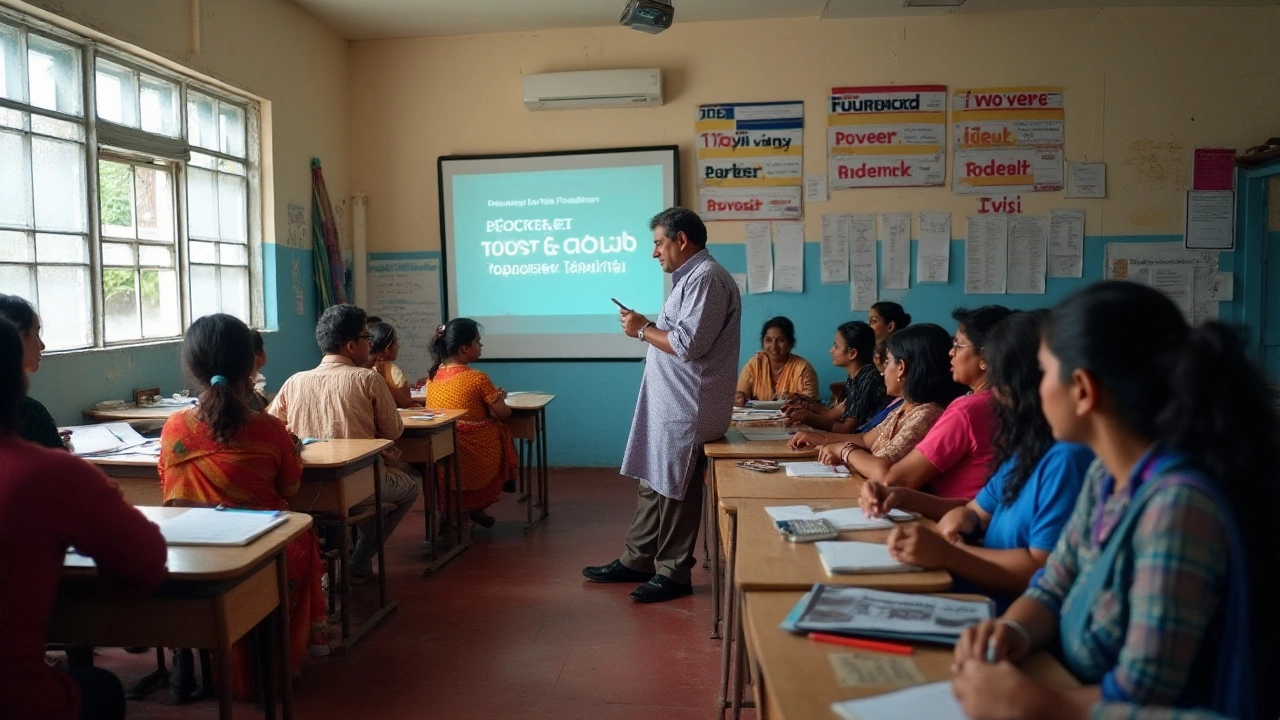Master the Art of English Fluency: Secrets and Techniques

Speaking English fluently is more than just a valuable skill—it's a key to unlocking countless opportunities in a globalized world. With such an extensive number of people communicating in English worldwide, gaining fluency opens the doors to new cultures, ideas, and possibilities.
This article delves into the many ways you can improve your English speaking skills, from daily habits to more structured approaches. Whatever your motivation, whether for personal or professional reasons, understanding the nuances of becoming fluent will help you gain confidence and proficiency.
Join us on a journey exploring tried-and-true methods to speak English with ease and clarity, using language you can master at your own pace. With practical advice and insight, this guide is here to aid you in your quest for greater communication in English.
- Understanding English Fluency
- Everyday Practices for Improvement
- Engaging in Conversations
- Immersive Language Techniques
Understanding English Fluency
Grasping the concept of English fluency begins with recognizing that fluency goes beyond mere vocabulary memorization or grammar rules. Fluency in a language, particularly in English, entails the ability to express thoughts, ideas, and emotions smoothly and efficiently. When someone achieves fluency, it suggests they can navigate various conversational scenarios with ease, adapting to both formal and informal settings without stumbling. This capacity is about using language instinctively rather than mechanically, somewhat akin to thinking in English itself.
A fluent speaker is often characterized by their ability to engage in discussions without being overly conscious of the language mechanics. They listen actively, comprehend swiftly, and respond appropriately. Historically, fluency is linked to the direct method used amongst native speakers, which encourages speaking and listening practice right from the outset. A well-known linguist once remarked, “The language is the road map of a culture. It tells you where its people come from and where they are going.”
Sonia Sotomayor said, "Until we get equality in education, we won’t have an equal society."
Studies reveal that fluency can be measured through various techniques, including assessing spontaneity, coherence, adaptability, and accuracy. According to language educators, a significant part of achieving fluency involves exposure and practice. This means actively engaging with the language as frequently as possible. The journey to fluency also requires embracing mistakes as part of the learning curve, as erring in language usage can often broaden comprehension significantly. In this context, achieving fluency implies a blend of confidence and competence.
In today's global context, with English being a bridge between cultures, fluency is indispensable. It's one of those communication skills that enriches personal and professional pursuits. Data from linguistic studies show that individuals who are fluent in English often experience fewer communication barriers and have greater access to diverse opportunities. For instance, in countries where English is a second language, achieving fluency is associated with better job prospects and academic advantages. Thus, understanding fluency encompasses recognizing its broad-ranging impacts on life. Looking at these elements, one can appreciate the nuances of English as a dynamic and versatile language, vital for international dialogue.

Everyday Practices for Improvement
When it comes to mastering English fluency, consistency is key. Like learning any new skill, speaking English requires daily practice. One of the simplest ways to surround yourself with English is by labeling items in your home or office with their English names. This method encourages passive learning and reinforces vocabulary through visual cues, making consciously practicing less daunting. Pairing these labels with verbal practice, reading them aloud, even when alone, further integrates these words into your everyday practice. It's like turning your own surroundings into a personal classroom where learning happens naturally and comfortably.
Another indispensable tip is to keep a daily journal in English. Writing regularly encourages you to think in English, strengthening your grammatical skills and your ability to construct sentences. Aim to write about your day, thoughts, and feelings. Over time, you'll notice improvements in how you express ideas. It may seem challenging at first, but think of it as a gateway to transforming fleeting thoughts into coherent English speech. Furthermore, reading your journal entries aloud combines both writing and speaking practice, providing comprehensive language development.
Language courses can be enormously beneficial, but practising with native speakers takes skill acquisition to the next level. Seek language exchange partners or participate in group conversations, whether online or in person. Use apps designed to connect you with language learners from different parts of the world. Engaging in these real-time conversations helps overcome the fear of making mistakes, as practical usage solidifies what is learned theoretically.
"The only way to speak English fluently is to surround yourself with it," advises linguist Michael Swan. "Engagement with native speakers allows you to adapt to different accents and colloquialisms, making your own speech more natural."
Don’t underestimate the power of listening. Dedicate a portion of your day to listening sources of English fluency, such as podcasts, radio stations, or audiobooks. Choose topics that interest you, which ensures you remain engaged and absorb more effectively. Whether it’s a morning news session or a bedtime storytelling ritual, consistent auditory exposure fosters comprehension in real-life situations. To enhance this practice, mimic what you hear. Imitation develops pronunciation and intonation, allowing your speaking skills to mirror the natural rhythm of native speakers.
If you're committed to improving, set clear goals and celebrate incremental successes. Consider starting with short-term targets, like learning a set number of new words each day or completing a conversation with locals without reverting back to your native language. These achievements boost your confidence and create a sense of accomplishment. Keep track of your progress through a structured approach—possibly utilizing excel sheets or apps that evaluate your milestones. Another effective method is to record yourself. In doing so, you gain another type of feedback as you listen back to your speaking habits and pinpoint specific areas needing attention.

Engaging in Conversations
Conversations are the heartbeat of language, and truly engaging in them is one of the most potent ways to achieve English fluency. When you participate in dialogues, you aren't just practicing speaking—you are practicing listening, interpreting and responding, too. An interaction might start off simple, but have the courage to dive into deeper discussions. This will not only challenge your vocabulary and grammar knowledge but also expand it. It's important to remember that the goal is to communicate, not necessarily to be perfect. The natural flow of conversation will help you improve organically as you adapt your language to fit different situations.
Practice opportunities are abundant, even if you're not in an English-speaking country. Consider joining language exchange meetups, where people meet either in person or over the internet to help each other with language skills. This kind of social setting allows you to hear diverse accents and colloquial phrases, enhancing your understanding of the language in real-world contexts. Don't shy away from making mistakes; they are valuable learning opportunities. You're bound to refine your pronunciation and pacing as you continue to converse.
"By engaging in English conversations, non-native speakers exponentially upgrade their communication skills and bolster their confidence," says language expert and author Stephen Krashen. His research emphasizes the importance of comprehensible input and the natural order of language acquisition.
For those who thrive on structure, incorporating conversation classes into your routine can be beneficial. Such classes are designed to simulate real-life speaking scenarios that you may encounter daily, ranging from ordering food at a restaurant to discussing world news. These classes are often led by experienced teachers who know how to guide students through the nuances of fluent speech, focusing on word choice, intonation, and polite speaking norms. Joining a group also delivers a sense of camaraderie, building a supportive environment where you can experiment with new phrases and terms.
In addition to formal settings, immerse yourself in informal chat sessions by either making an English-speaking friend or utilizing technology. Apps and online platforms specially crafted for language learners offer chat features where you can easily find a conversation partner. Consistent practice leads to steady improvement. When you're engaging in conversations regularly, you begin to develop muscle memory for speaking, which is key in achieving English fluency. It's notable that engaging with native speakers online or through travel can unveil cultural differences in conversation style, providing another layer of learning. The effort you put into these exchanges will pay off tremendously as you notice increased comfort and adaptability in various speaking scenarios.

Immersive Language Techniques
Diving headfirst into a language experience, often known as immersion, is one of the most effective ways to achieve English fluency. It's the classic "sink or swim" approach where you're fully surrounded by the language in various settings, pushing you out of comfort zones and into real learning. An immersive environment facilitates rapid improvement, as it mimics natural language acquisition processes.
Consider creating a micro-environment at home that promotes learning. Transform your phone and computer settings to English, dive into English movies and TV shows, particularly those with subtitles to match spoken words with text. Engage in language exchanges with native speakers, an essential technique where you teach them your language, and they teach you English, fostering mutual understanding and cultural exchange.
Books and articles are your gateways, so read as much and as diversely as possible. Choose topics that intrigue you to maintain interest and challenge your understanding. Writing, often overlooked, reinforces what you've learned, so keep a journal or start a blog. These efforts ensure the active use of new vocabularies and grammatical structures. Embracing mistakes is important—they are signs of effort, and every mistake made is an opportunity to learn and improve.
Submersing in English Media
Media consumption offers endless opportunities. Create a playlist of English music and sing along, focusing on pronunciation and rhythm. Podcasts, with their varied topics and accented voices, enhance listening skills and comprehension. Aim for consistency, as regular exposure perfects communication skills over time. "The more that you read, the more things you will know. The more that you learn, the more places you'll go," once said Dr. Seuss, emphasizing the power of media in self-education.
Lastly, traveling to English-speaking countries is the ultimate immersive technique. Even if traveling isn't feasible, many cities globally have English-speaking communities to interact with. Sharing experiences, understanding different dialects, and engaging with cultural nuances contribute to fluency development more than any textbook can. Remember, speaking starts with listening—as you absorb more, you'll naturally begin to reproduce the language, increasing your confidence bit by bit.
